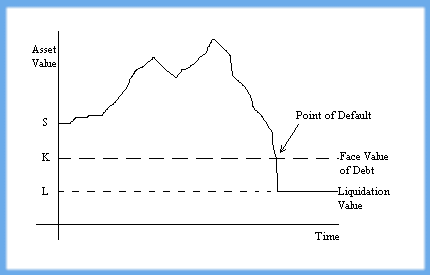 |

|
|
Capture The Moment: FirstKnow.It
|
|
|
 |
|
| Financial Technology |
| |
The crux of the concept is that when a company defaults on its debt, it surrenders its assets to its creditors in settlement of its liabilities.
This situation can be characterised in terms of financial options using the Black-Cox model. Effectively, the lender has written a put option for the borrower, agreeing to accept the assets in settlement of the payment obligation in the event their value should fall below the face value of the debt. The exercise price on the option is therefore equal to the face value of the debt and the debt and the option have the same maturity date. Following a default, the lender liquidates the assets and loses the difference in value between the face value of the debt - the exercise price - and the liquidation value of the assets.
|
| |
 |
| |
As the put option encapsulates the credit risk, valuing the option enables us to calculate the impairment of the value of an obligation due to the risk of default.
Key to these ideas is to choose a financial option which accurately characterises the default situation - there are many kinds of financial option. The option must recognise the fact that companies can default on debts before they mature. Also when a company does default, often only a fraction of the value of the assets of the business as a going concern is actually recovered, causing a loss given default. This can accurately be modelled with the digital option.
As a company's share price falls, the credit risk increases and the value of the put option increases. FirstKnow.It calculates the sensitivity of the option value to changes in share price. This value, an adaptation of what is commonly called the "delta" of the option, is traditionally used by options practitioners to hedge their exposures to options positions. This "Equivalent Equity Position" (EEP) provides a creditor with the necessary information to short a borrower's shares to eliminate a credit exposure*. Also, it quantifies the exposure of the creditor to the borrower's equity value - a key measure of "capital at risk". The sensitivity of the EEP to changes in share price is also calculated, quantifying the sensitivity of the capital at risk to share price movements. To illustrate the EEP concept, at the time of writing, a 12 month $1 million credit exposure to US-based El Paso Corp implies an EEP of $7,200 and each 1% fall in share price increases the EEP by $320. For
small share price increments, the $1,000,000 credit exposure would change in value by the same amount as $7,200 directly invested in the equity of El Paso Corp.
For companies with equity traded on stock markets, the principal parameters for evaluating the put option can be directly derived from the companies' share prices. Click here for further technical information about translating market and other data into credit ratings.
Note, the analysis produced by FirstKnow.It does not take into account other qualitative factors which analysts may take into account in their credit decision such as company size, strategic relationships with other companies etc.. We present a pure options analysis and suggest users form their own views on these other issues.
* In practice, in most cases, the delta shows a high degree of non-linearity and simply shorting the shares is only viable for institutions with very active trading floors and low transaction costs or through use of combinations of options contracts to eliminate the non-linearity.
|
|
 |
|